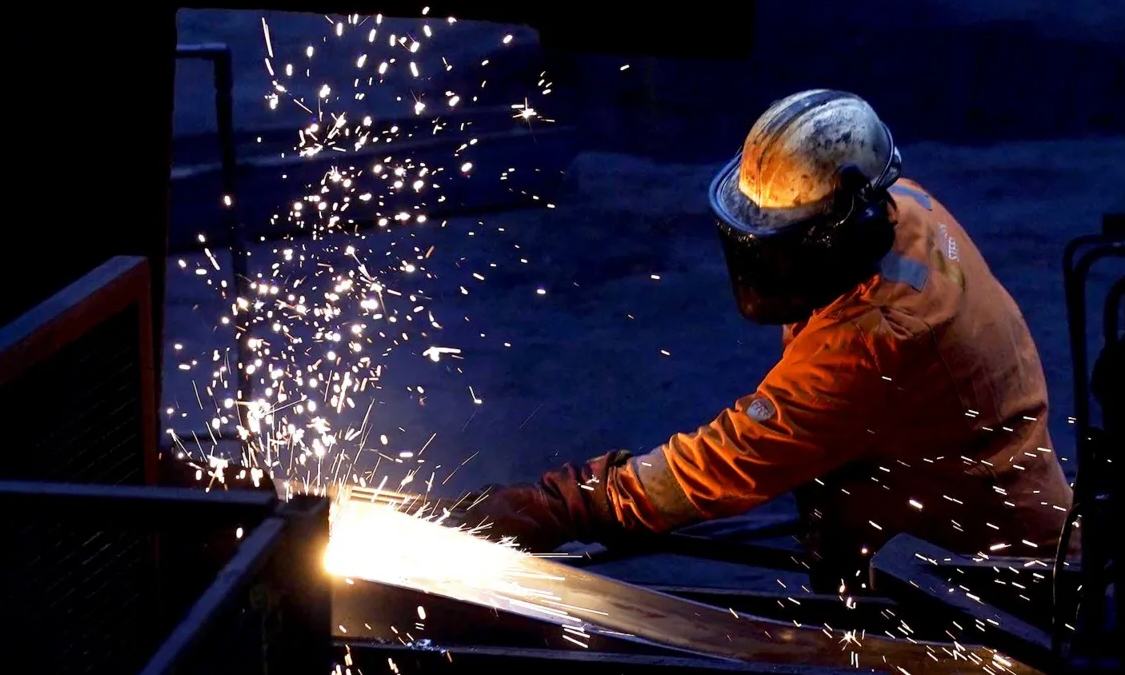The chaos, uncertainty, demoralisation and directionless facing steelworkers at Scunthorpe, Lincolnshire, home to Britain’s only remaining primary steelmaking facility, is largely ignored by the media. But not only in Scunthorpe, but across South Yorkshire, steel workers are being laid off, plants are lying idle, cutting-edge production lines are rusting, and wages are being paid late.
In short, uncertainty and fear for the future hangs heavy in the air.
On the face of it, it seems impossible that Britain, once renowned as the manufacturing workshop of the world, should have reached such a pass. After all, as a 2023 article on the Sky news website pointed out:
“Iron and steel (the latter is simply an iron alloy with a tiny amount of carbon) are the backbones of the modern world.
“They provide the skeletons of buildings, the shells of cars, and the fibre of bridges.
“Pretty much every manufactured product you touch on a daily basis will owe its existence to steel: even if it doesn’t have any inside it, it will have been made with machines and tools themselves made of steel.” (Why the British steel industry is on the brink of extinction – or a green resurrection by Ed Conway, 7 April 2023)
Manufacturing gives way to finance capital
Yet it was its very industrial pre-eminence that allowed British capitalists to expand their reach first as exporters of manufactured goods and then as exporters of capital across almost the entire globe, creating the largest empire the world has ever seen and developing Britain, the world’s first industrial capitalist economy, into the world’s first and strongest monopoly-capitalist (imperialist) power.
But as Lenin pointed out back in 1916, the development of ‘free trade’ into monopoly capitalism, the monopolists’ need to constantly expand their markets and maximise their profits, and the steady impoverishment of the proletarian masses, had created a new reality at the heart of the world’s biggest capitalist economies – it was now only possible to keep generating decent profits by relocating manufacture to where the costs of labour, land, raw materials and other inputs (notably energy) were all lower.
This generated superprofits that kept the capitalist system viable back in its heartlands and enabled the ruling class to buy off discontent among its workers – but it was also an essentially irreversible process of the steady deindustrialisation of western capitalist domestic economies.
The need to export capital is a vital need of monopoly finance capital, and no bourgeois government has either the will or the ability to reverse it. This was shown even during the ‘glory days’ of the postwar nationalisation. The state took over the running of what were already failing industries based on old machinery, and which had only been kept economically viable by Britain’s monopoly over markets in its colonies (ie, where consumers had no option but to buy British).
When the colonies began to break free, their markets were opened up to competition from other manufacturers, and British industrial output was increasingly undercut by its more technically advanced rivals. The government’s job (on behalf of the British ruling class) was not to reinvigorate these industries with massive investment in new machinery but to shutter them as being simply ‘uneconomic’ in free-market conditions.
After all, if we can buy cheaper from abroad, why do we need to make it at home? This echoes the conversation that was had regarding agricultural production in the 19th century, when Britain’s industrialists felt that it was simply wasteful to bother using expensive land and manpower to produce food for Britain’s workers domestically. Why not just ship it in from the colonies while we continue to sell them our manufactured goods?
Today, of course, Britain does neither. Almost its entire economy has been transformed into a parasitic excrescence on the back of the world’s agricultural and industrial labourers, exporting capital and importing goods, while offering insanely expensive management and consultancy ‘expertise’ and money laundering facilities.
Essentially, the British ruling class and its mandarins expect to continue in perpetuity the wheeze whereby they send their money abroad and direct other countries in how their economies should be run to facilitate the greatest possible returns for the owners of capital in London, Paris, Berlin and New York.
Lots of talk but no real clue
Losing the ability to produce its own steel would leave Britain excessively at the mercy of the vicissitudes of the world market and the interests of the overseas monopolists who would be in control of all of it. Therefore, politicians today pay lip service to “saving Britain’s steel production”, but they can deliver nothing of substance beyond a few empty phrases within the present parameters of capitalist production for profit.
However essential it is to have one’s own capacity to produce steel, this still has to be profitable otherwise it will not happen unless some emergency, such as war, means that bourgeois interests are too threatened to do without it. There are signs that the British bourgeoisie is to some extent contemplating the possibility of war, but are they worried enough actually to save the industry?
Meanwhile, the three steel unions – Community, Unite and the GMB – have failed utterly to hold either the government, the ruling class or the economic system to account. Since their leaders, stuck inside the parameters of bourgeois economic thinking, are unable to explain the root causes of the problem either to themselves or to their members, they have no strategy beyond falling on their knees before the same Labour government that is overseeing the industry’s final demise.
Moreover, it should be noted that all three of these unions are affiliated (shackled) to the Labour party. This dysfunctional relationship, in which loyalty to the imperialist Labour party trumps every other concern (and guarantees well-remunerated careers for union leaders), is at the root of each union’s unwillingness and inability to fight for its members – even though the very livelihoods of those members is at stake.
While several conflicting contradictions have produced the fiasco we see today, the decades-long process of obediently shuttering British manufacturing, overseen by Labour and Tory governments alike, and facilitated by servile trade union leaders, are at the root of the matter.
Labour’s role in this process has been essential. We witnessed during the years of Margaret Thatcher’s Tory government how Neil Kinnock and his shadow cabinet sold out struggle after struggle put up by industrial workers – in particular the year-long and heroic miners’ strike of 1984-5, which was aimed at defending not only the mining industry but all of Britain’s industrial base and workforce.
Any suggestion regarding the importance of domestic industrial investment was dismissed during the years of Gordon Brown’s premiership as “prolonging the lives of dinosaurs”. In fact, Labour has put up no defence of British industry, either in office or out of it. Steel production in Britain today is uncompetitive so the market demands its collapse. To make it competitive would also require massive investment that, in a saturated market, nobody is prepared to make.
‘Green’ steel production is no doubt desirable, but conversion would also require huge investment, and the green method of producing steel would in all probability be more costly than the traditional methods that would be retained by competitors. Being uncompetitive, green steel in this country probably doesn’t stand a chance.
This is why so far all ‘green’ steel has really amounted to is a justification for allowing the closure of traditional steel-making centres (such as south Wales), with all the accompanying decimation of skills, jobs and communities. New, modern, ‘green’ production facilities to replace those being shuttered are conspicuous by their absence.
Likewise, ever more remote and corporate ‘ownership’ has contributed to broken morale. No longer a British national asset, this strategic industry has been sold off and asset-stripped, fed out to profit-hungry capitalist corporations, initially based in Europe and later in India – one of the few countries able to compete on the world steel market without substantial subsidies.
Yet even in India, the global drive to switch to less carbon-intensive production techniques requires considerable state intervention to bring it about. The truth is that such transitions are simply too costly for even the biggest corporation to bear the costs. If governments are going to legislate such changes, they also have to work out how they are going to be paid for.
The call for renationalisation, if properly implemented, would mean the expropriation without compensation of corporate owners. And workers’ vision cannot be pinned to the past, to the shambolic days of the British Steel Corporation, but set firmly on the creation of a really new steel industry, tasked with producing for Britain’s present-day transport, infrastructure, construction and industrial needs.
Such a transformation is next-to impossible under the present conditions of capitalist economic crisis, capitalist ownership and a capitalist-serving government. Nevertheless, genuine renationalisation is a key demand for British workers demanding a decent future – for themselves and for future generations.
The battle to save Scunthorpe
Scunthorpe in North Lincolnshire was an industrial town created largely from scratch in rural surroundings 160 years ago. Based on Lias ironstone reserves, its sole purpose was to manufacture iron and steel. If Scunthorpe closes, Britain will be the only imperialist economy without a primary steel industry.
The privatisation of the British Steel Corporation, whose last remnants survive in the form of British Steel (owned by China’s Jingye group) and Liberty (owned by India’s Tata corporation), demonstrates the abandonment of core strategic industries to the uncertain forces of the world market – a market in which old plants, high overheads (in particular the cost of energy) and expensive western workforces are simply uncompetitive.
The argument between Jingye and the Labour government as to who should cover the cost of the new investment needed to modernise the plant and make it economically viable essentially uses the football of the workers’ livelihoods.
Jingye has estimated that it will cost £1.25bn to build new electric arc furnaces and has asked Keir Starmer’s government to cough up £1bn towards the bill. However, the pundits are probably advising the government that even with new electric arc furnaces the business would struggle to survive and it would have to expect to spend even more in the future to keep steel production going.
So although the Labour party has supposedly earmarked £2.5bn for steel ‘investment’, it has only been prepared to offer Jingye £500m. It is doubtful how much of the £2.5bn the government genuinely wants to plough into new production (as opposed to oiling the wheels of new rounds of ‘restructuring’ via redundancies and closures).
At the time of writing, Jingye’s response to the government’s offer was to predict closures by June, with up to 2,700 (out of 3,500) jobs lost. And for every steel job lost, a further seven will follow in local supply chains and service providers catering to the needs of the steelworks and its employees.
As the football is kicked between Jingye and the government, the unions are ‘doing their bit’. Not by mobilising workers and the wider working class behind a campaign for complete renationalisation and a programme of massive national investment, but by going cap in hand to the employers – begging them to retain jobs on any terms, offering up workers’ hard-won wages and conditions on the sacrificial altar.
Alongside this, Labour party MPs are staging beauty parades offering the best terms to the employers if they will invest in Scunthorpe rather than in (Tory-controlled) Redcar or Teesside in the North East.
But workers need new investment in both Redcar and Scunthorpe, not some suicidal competition between the two. Especially as the employers at Scunthorpe are now moving the goal posts and threatening closure by a thousand cuts.
Ninety-five percent of Britain’s rail track is made from Scunthorpe steel. Network Rail has apparently been secretly stockpiling track in case of closure. Even Tory MPs have been calling for nationalisation. One proposal from government is to use the Civil Contingencies Act 2004, primarily aimed at terrorism, to use emergency powers to take control of the works.
But beyond this talk, there is no indication of a serious attempt to reverse the decline in British industry, which would require a national plan covering all key industries, the energy sector and education.
Yet some in the commentariat are waking up, too late, to the realisation that without domestic steel production there is minimal chance for any other industrial growth in Britain. No ability to make trains and trams. No ‘northern powerhouse’ or levelling up. And of course (which is what is really taxing the ruling class and its mandarins) no arms industry.
Workers must take matters into their own hands
The mood of steelworkers in Scunthorpe and other industrial centres in Yorkshire is one of despondency and demoralisation. Piecemeal job losses over decades, constant changes of ownership, deskilling, pointless divisions, splits, rivalry, one-upmanship between the trade unions and a constant barrage of anti-industry ‘green’ propaganda has sapped energy and hope.
There is no prospect of a saviour in shining armour riding to their rescue. Salvation rests in the hands of the workers themselves.
Yes to the call for nationalisation, which would at least offer a short-term breathing space if not a long-term solution. But we should recall that nationalisation of the old type did not lead to a surge of new state investment and overhaul in this vital sector, but to a programme of steady closures as uncompetitive old plants with Victorian machinery were shuttered and nothing new was brought in to replace them. A story that was repeated across the British industrial landscape.
Those who run the last vestiges of our steel industry today are not interested in Britain’s manufacturing base; they are interested in whether there is any profit to be made from these remnants of a once-mighty industry. There’s not much point selling the crown jewels to capitalists from abroad and then complaining that ‘these foreigners’ don’t care about our national interests!
Nor does Britain really have a singular ‘national interest’. What was in the interests of the British financier class is what was done: asset stripping and selling off old industry and exporting freed capital to production abroad where workers, land and inputs are all cheaper and more profitable.
What is in the interests of British workers is to save the jobs, skills and communities that are centred on the steel industry, and keep them alive to fulfil the core functions of a future socialist planned economy.
A call to save the industry now has to be made: Stop the closures, keep the furnaces alive, refuse the redundancies and illusory pay-off packages, stop and prevent the asset-stripping, turn Scunthorpe steelworks into a centre for industry and work.
Save steel, save jobs, save communities, save the future.










